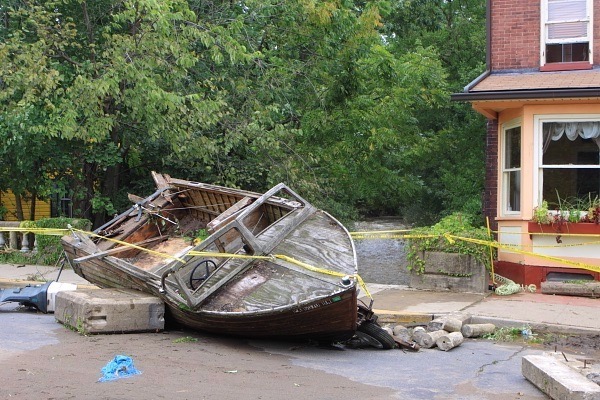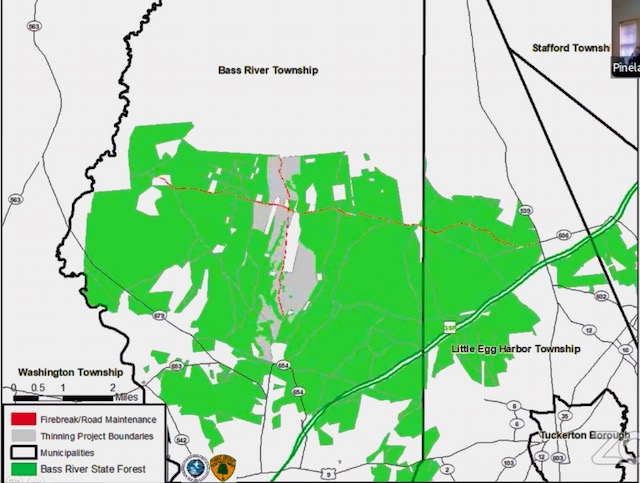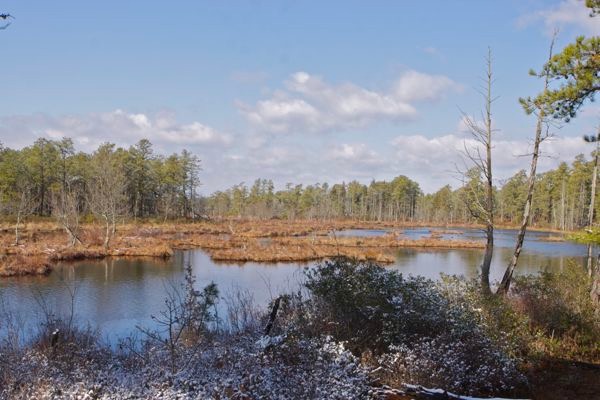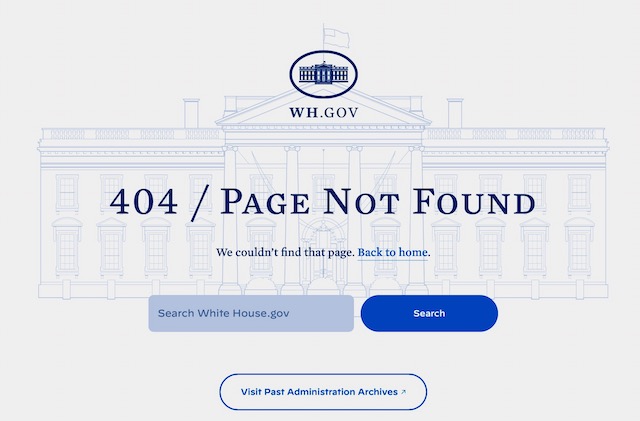Murphy DEP Finally Proposes Inland Flood Rules – Current Rainfall, Stormwater Volumes, & Flood Elevations Already Exceed DEP’s New Standards
Rule Based On The 100 Year Storm Event, Despite Suffering Several 500 Year Storms
DEP Rule Is Obsolete Before It Is Adopted
DEP Ignores Land Use Planning And Instead Relies On The Myth of “Resilience”
[Update: 1/15/22 – Even NPR gets it and is more critical than NJ environmentalists – billions of dollars of infrastructure money is being wasted by under-designed systems and lax regulatory standards, just like we noted in US Army Corps of Engineers New Orleans $14 billion under-design boondoggle. DEP is repeating the same errors:
After five years (second term), numerous self promotional press releases and toothless Executive orders, and several massive deadly floods, on Thursday October 27 the Murphy Administration finally proposed new rules to update decades old inland flood maps and recognize significant increases in rainfall and stormwater runoff that have exacerbated NJ’s vulnerability to flooding.
Even larger storms and floods are projected due to the climate emergency. This science is not new and has been clear for a long time – e.g. I wrote this 12 years ago:
The University of New Hampshire (UNH) just issued an important and amazingly timely Report: Trends in Extreme Precipitation Events for the Northeastern United States 1948-2007 […]
Why is no one analyzing the same rainfall and flooding data and correlating it with land use changes here in NJ? (hint: it’s not due any to lack of hydrology data or land use/land cover data or precipitation data)
Why is the relationship between global warming and increased storm frequency/intensity/pattern rarely if ever made by the same tired meteorologists quoted in the NJ news stories?
Of course, the liars and deniers at NJ BIA shamefully dispute the science:
NJBIA Deputy Chief of Government Affairs Ray Cantor said that’s good news, but the science behind the establishment of new standards is still questionable.
(read the DEP press release and read the “formal” DEP rule proposal – which will appear in the December 5, 2022 NJ Register).
Before we analyze the merits of the complex 117 page DEP proposal, we must note that DEP disingenuously continued their manipulation by issuing the Press Release under a “ICYMI” lede and inserted a new “courtesy copy” link to the rule proposal on the original October 13 press release (the text of the rule proposal was NOT included in the original), a track covering slight of hand that would make Orwell blush.
No Commissioner LaTourette, we didn’t “miss it” – we saw exactly what you did in duping the public on October 13 by creating a false impression that a Stakeholder outline was a rule proposal and then allowing the news media to print a false story, without making any effort to correct it.
NJ Spotlight also has egg on their face, because we told them that two prior false news stories stated as fact that DEP had proposed the rule already! and they did not correct their false reporting. Now that that is obvious, it will be interesting to see how they navigate those errors when they write about the actual “formal” proposal, see:
We need a few days to read and digest the entire rule, but we can make a few big picture observations today:
1. Just as we predicted, DEP based the rule on the 100 year storm event, despite the fact that NJ already has experienced several far more severe 500 year storm events.
We predicted DEP would do that back in February, when DEP released their Cornell rainfall study, see:
I explained the significance of the flawed 100 year storm in this September 4, 2021 post:
The US Army Corps of Engineers recently were forced to admit a similar huge engineering blunder in New Orleans, due to reliance on flawed design standards, a $14 billion mistake: (Federal Register Notice, 4/2/19)
Even NJ Spotlight understands the 500 year storm see:
DEP’s proposal documents the fact that NJ has suffered 500 year (or more) Storm events and flooding (@ page 10):
Specifically, the remnants of Tropical Storm Ida resulted in flooding significantly more severe than FEMA’s published 100-year flood at various locations in New Jersey:
Raritan River at Bound Brook:
- Flooding during Tropical Storm Ida equaled 1999’s Hurricane Floyd, which was the highest elevation ever recorded at Bound Brook.
- Including Floyd, flooding at this location in the past 23 years has equaled or exceeded FEMA’s 500-year flood elevation three times.
- The Raritan River during Tropical Storm Ida peaked at 42.13 ft NGVD (41.21 ft NAVD) which is 3.01 feet above FEMA’s 100-year elevation (38.2 ft NAVD) and 0.21 ft above FEMA’s 500-year flood elevation (41.0 ft NAVD).
Raritan River at Bridgewater
- Flooding during Tropical Storm Ida peaked at roughly FEMA’s 500-year flood elevation (41.0 ft NAVD) which is 2.8 ft above FEMA’s 100-year flood elevation (38.2 ft NAVD)
Millstone River at Manville:
- Flooding during Tropical Storm Ida peaked at roughly one foot above FEMA’s 500-year flood elevation (43.5 ft NAVD) which is 2.5 ft above FEMA’s 100-year flood elevation (41.0 ft NAVD). Thus, flooding at this location peaked at approximately 3.5 feet above FEMA’s 100-year flood elevation.
DEP then explains the significance of the 500 year flood event: (@page 11)
These examples illustrate not only that Ida was a significant flood event that exceeded the anticipated flooding depicted on available flood mapping products, upon which many roads and buildings were financed, constructed, and insured in the impacted communities, but also that there is an upward trend in the number and severity of flood events in the State. As noted above, flooding in Bound Brook has exceeded FEMA’s 100-year flood elevation four times and FEMA’s 500-year flood elevation three times since 1999, which leads to the conclusion that we are already experiencing increased flooding as compared with past recurrence interval calculations.
Despite the facts that NJ is already experiencing 500 year floods and that climate science projects that extreme storms will significantly increase in rainfall amount, rainfall intensity (short severe bursts of rainfall that create floods), and extreme rainfall frequency, the DEP did not even use the 500 year storm.
Instead, DEP merely added a 25% “safety factor” addition to the current 100 year storm event they’ve been using for decades.
And look how they then falsely stated that it would be adequate – a statement made before the facts on 500 year storms are summarized on page 10-11: (@page 5):
This rulemaking incorporates anticipated greater depths of precipitation for the two, 10, and 100-year storm events for the purposes of stormwater management. These proposed amendments are necessary to ensure that buildings, roads, stormwater management features and other structures are designed and constructed to manage and be protective for today’s flood conditions and precipitation as well as anticipated future conditions and precipitation. […]
Specifically, the flood hazard area design flood elevation is based on a flood that is 25 percent greater than the 100-year peak flow rate in the stream or river being analyzed and mapped.
The technical regulatory fine print for this standard is on page 102:
6. Table 3.6B below sets forth the change factors to be used in determining the projected 100-year storm event for use in this chapter,
The 100 year storm – even with an additional 25% “safety factor” increment – can not “ensure that buildings, roads, stormwater management features and other structures are designed and constructed to manage and be protective for today’s flood conditions and precipitation as well as anticipated future conditions and precipitation.”
That proposed new standard is already exceeded now, never mind projected climate driven increases.
DEP admits this multiple times in the proposal:
“More than 12 rivers exceeded their 100-year flood levels”
“On August 27 and 28, 2011, Hurricane Irene resulted in record breaking floods on many New Jersey streams, with 33 USGS stream gauges recording peak flows equal to or greater than the 100-year recurrence interval (USGS, 2011).”
DEP exposed the inadequacy of the 100 year design storm for the purpose of justifying their new 25% “safety factor”.
But, ironically, in doing so, DEP also exposed the flaws in relying on the 100 year flood.
2. DEP Ignores Land Use Increases In Development. DEP’s proposed new standards are obsolete for the same reasons that DEP correctly rejects current rainfall methods
Just some basic observations make it obvious that, in addition to underestimating extreme rainfall amounts and flood elevations, DEP is failing to consider a basic driver of increased flood impacts.
Flooding is a combination of the amount and timing of rainfall and the ability of the landscape to absorb that rainfall.
NJ is a highly developed state.
Development destroyed forests, wetlands, and natural landscapes that absorb rainfall and dampen flooding. It also puts people and property at risk when located in areas prone or vulnerable to flooding.
Development also increases impervious surfaces that dramatically increase the generate stormwater runoff volumes.
Yet the DEP proposal ignores the changes in land use and impervious surfaces that generated huge volumes of stormwater that contribute to bad land use decisions that result in devastating deadly flooding.
The proposal ignores existing development, it will influence new development at the margin, and it therefore depends on market forces, not any overarching State Land use and climate plan or infrastructure investment program.
A critical Star ledger editorial got that:
“A lot of New Jersey was developed prior to the stormwater regulations,” Obropta said. “The state needs to require municipalities to begin retrofitting existing development with stormwater management if we have any hope to reduce flooding.”
There is “no hope”. The proposal ignores existing development.
The proposal does very little to cap or reduce impervious surfaces or stop the loss of natural lands like forests, wetlands and stream buffers. It guarantees that the flooding problems will get worse.
3. DEP Rejected A Land Use Planning Approach And Policy Of “Strategic Adjustment” And Relies Primarily On Engineered “Resilience”.
The most cost effective and environmentally sound approach to stormwater management and flooding – particularly in light of projected climate driven more extreme weather events – is land use planning backed by regulation. That approach would include putting teeth in DEP’s current scattershot reactive reliance on voluntary “willing sellers” in the “Blue Acres” land acquisition program and restrictions on NJ’s “right to rebuild” storm damaged properties.
DEP has land use planning and regulatory powers that can be deployed to promote “strategic retreat” from flood prone lands, restrict rebuilding of flooded structures, and stop building in flood prone places or places that destroy forests, stream buffers, and wetlands. see:
Assertion of State and DEP land use planning powers is such a taboo topic, DEP doesn’t even talk about it anymore. Not even in the narrative description, never mind the regulatory text of the proposal. see:
But DEP effectively abandoned land use planning in favor of the slogan “resilience”, and they openly admit it:
As the State repairs the damage from these devastating impacts, it is in the interest of the public’s health and safety that future development of public and private structures is as resilient as possible to withstand the increasing frequency and intensity of precipitation events, such as Ida.
And even highly technical details – and there are a lot of them that I have not considered today – like the groundwater recharge requirements retain the 2 year storm volume and flawed average annual recharge approach – which are overwhelmed by extreme weather – do little to nothing to reduce flooding.
In addition to getting the science and regulatory details wrong, the entire DEP approach is fatally flawed and based on the myth of “resilience”.
Resilience is much like flawed coastal engineering (sea walls, beach replenishment, etc) and hard engineered flood control projects. They give a false sense of security, cost a ton of money to build and maintain, and don’t work.
We can’t engineer and build our way out of this mess. And it will only get worse.





